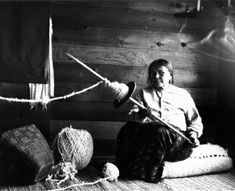
SALISH WEAVING: AN ART NEARLY LOST

Selisya, a Musqueam weaver, spinning with a traditional Salish spindle, Photo by C.F. Newcombe, courtesy of Royal British Columbia Museum #PN1165, photo 1915.
Salish weaving is an ancient art. Woven objects from 4,500 years ago have been excavated by archaeologists at Musqueam. Weaving tools have been found at several more recent sites in the area.
The eighteenth and the nineteenth-century journals of European explorers and traders report a well established weaving tradition in the region. They record that native people often wore wool blankets, some of which were patterned, and that such blankets were highly valued by them, in part because they were made from scarce materials, the wool of mountain goats and the hair of dogs. Some examples of these blankets were collected and eventually found their way into museum collections in North America and Europe. Museums also hold collections of other forms of Coast Salish weavings: leggings, tumplines (burden straps), belts, mats, and baskets.
Regrettably, little information was recorded on the production and use of these weavings. Most of those in collections have little identifying information, so that it is difficult to establish clear patterns of regional variation in styles and materials, or of changes over time. The names of the women who created these objects are rarely known. The Coast Salish had no written language, so the only record these earlier people have left is the weavings themselves and their related tools. It was only in the twentieth century that anthropologists began to systematically record information from native makers and users of weavings. By that time Coast Salish culture had been profoundly affected by European influence.
It was not until the 1960s that Salish blanket weaving began to be revived, first at Sardis and more recently at Musqueam. By then the tradition was almost entirely gone. The people responsible for the revival taught themselves, by studying examples of old weavings and questioning elders to learn whatever they remembered of the art.
- Wendy Grant John, Founder of the Musqueam Weavers
(Text adapted from Johnson & Bernick, Hands of our Ancestors: the Revival of Salish Weaving at Musqueam, UBC Museum of Anthropology Museum Note No. 16, 1986:2)


